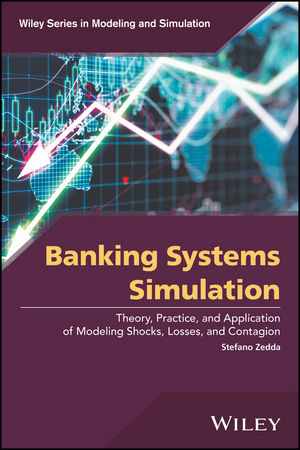
Banking Systems Simulation
John Wiley & Sons Inc (Verlag)
978-1-119-19589-4 (ISBN)
Combining both academic and institutional knowledge and experience, Banking Systems Simulation: Theory, Practice, and Application of Modeling Shocks, Losses, and Contagion presents banking system risk modeling clearly within a theoretical framework. Written from the global financial perspective, the book explores single bank risk, common bank exposures, and contagion, and how these apply on a systemic level. Zedda approaches these simulation methods logically by providing the basic building blocks of modeling and simulation, and then delving further into the individual techniques that make up a systems model.
In addition, the author provides clear and detailed explanations of the foundational research into the mathematical and legal concepts used to analyze banking risk problems, measures and data for representing the main banking risk sources, and the major problems researchers are likely to encounter. There are numerous software descriptions throughout, with references and tools to help readers gain a proper understanding of the presented techniques and possibly develop new applications and research. The book concludes with an appendix that features real-world datasets and models.
In addition, this book:
• Provides a comprehensive overview of methods for analyzing models and simulating risk for banking and financial systems
• Provides a clear presentation of the technical and legal concepts used in banking regulation
• Presents unique insights from an expert’s perspective, with specific coverage of assessing risks and developing what-if analyses at the systems level
• Concludes with a discussion of applications, including banking systems regulation what-if tests, cost-benefit analysis, evaluations of banking systems stability effects on public finances, dimensioning, and risk-based contributions for Deposit Guarantee Schemes (DGS) and Resolution Funds
Banking Systems Simulation: Theory, Practice, and Application of Modeling Shocks, Losses, and Contagion is ideal for banking researchers focusing on computational methods of analysis as well as an appropriate reference for graduate-level students in banking, finance, and computational methods.
Stefano Zedda is Researcher in Financial Mathematics at the University of Cagliari in Italy and qualified as associate professor in banking and corporate finance. His research is mainly focused on quantitative analyses for banking and finance, with a particular focus on banking systems modeling and simulation. In 2008, Zedda developed the mathematical modeling and software implementation of the Systemic Model for Banking Originated Losses (SYMBOL), further developed during his activity at the European Commission. The Commission subsequently adopted it as a standard tool for testing banking regulation proposals. Stefano Zedda’s research interests include banking, financial mathematics, and statistics, specifically simulation of banking and financial systems stability, banking regulation impact assessment, and interactive agent simulation.
Stefano Zedda is Researcher in Financial Mathematics at the University of Cagliari in Italy and qualified as associate professor in banking and corporate finance. His research is mainly focused on quantitative analyses for banking and finance, with a particular focus on banking systems modeling and simulation. In 2008, Zedda developed the mathematical modeling and software implementation of the Systemic Model for Banking Originated Losses (SYMBOL), further developed during his activity at the European Commission. The Commission subsequently adopted it as a standard tool for testing banking regulation proposals. Stefano Zedda's research interests include banking, financial mathematics, and statistics, specifically simulation of banking and financial systems stability, banking regulation impact assessment, and interactive agent simulation.
Foreword xi
Introduction xv
1 Banking Risk 1
1.1 Single Bank Risk 4
1.2 The Basel Committee on Banking Supervision Approach to Regulation 14
1.3 Banking Risk Modeling and Stress Testing 33
1.4 Contagion 36
1.5 System Modeling 41
2 Simulation Models 45
2.1 Simulating Shocks: Idiosyncratic Shocks, or Exogenous Failure of Individual Banks 49
2.2 Simulating Shocks: Stress Testing 54
2.3 Simulating Shocks: Systematic Common Shocks 56
2.4 Simulating Shocks: Common Shocks 58
2.5 Estimation of Losses Variability and Assets Riskiness 70
2.6 Simulating Shocks: Correlated Risk Factors 82
2.7 Simulating Shocks: Combining Idiosyncratic and Common Shocks 87
2.8 Correlation 89
2.9 The Interbank Matrix 98
2.10 Loss Given Default 127
2.11 Interbank Losses Attribution 132
2.12 Contagion Simulation Methods 133
2.13 Data and Applied Problems 140
3 Real Economy, Sovereign Risk, and Banking Systems Linkages 149
3.1 Effects of Bank Riskiness on Sovereign Risk 150
3.2 Effects of Sovereign Risk on Bank Riskiness 153
3.3 Linkages to the Real Economy 154
3.4 Modeling 156
3.5 Implementation 159
4 Applications 163
4.1 Testing for Banks–Public Finances Contagion Risk 163
4.2 Banking Systems Regulation What-If Tests 164
4.3 Banks’ Minimum Capital Requirements: Cost–Benefit Analysis 169
4.4 Deposits Guarantee Schemes (DGS)/Resolution Funds Dimensioning 174
4.5 Computing Capital Coverage from Assets PD and Bank PD 178
4.6 Computing Banks Probability to Default from Capital Coverage and Assets PD 180
4.7 Risk Contributions and SiFis 182
4.8 The Regulator’s Dilemma 202
Appendix: Software References and Tools 205
References 223
Index 235
| Erscheinungsdatum | 04.05.2017 |
|---|---|
| Reihe/Serie | Wiley Series in Modeling and Simulation |
| Verlagsort | New York |
| Sprache | englisch |
| Maße | 152 x 236 mm |
| Gewicht | 499 g |
| Themenwelt | Mathematik / Informatik ► Mathematik ► Wahrscheinlichkeit / Kombinatorik |
| Technik ► Maschinenbau | |
| Wirtschaft ► Betriebswirtschaft / Management ► Allgemeines / Lexika | |
| Wirtschaft ► Betriebswirtschaft / Management ► Finanzierung | |
| Betriebswirtschaft / Management ► Spezielle Betriebswirtschaftslehre ► Bankbetriebslehre | |
| ISBN-10 | 1-119-19589-6 / 1119195896 |
| ISBN-13 | 978-1-119-19589-4 / 9781119195894 |
| Zustand | Neuware |
| Haben Sie eine Frage zum Produkt? |
aus dem Bereich


